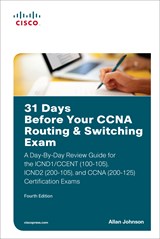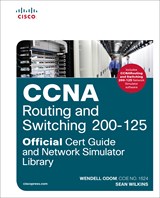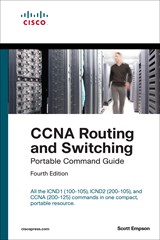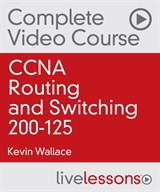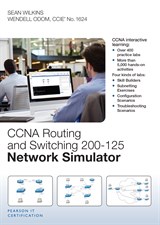Author: Allan Johnson
Publisher: Cisco Press
ISBN: 978-0-13-446619-4
Copyright © 2017 Cisco Systems, Inc.
Contents at a Glance
Day 31: Networking Models, Devices, and Components
Day 29: Switch Configuration Basics
Day 28: VLAN and Trunking Concepts and Configurations
Day 27: IPv4 Addressing
Day 26: IPv6 Addressing
Day 25: Basic Routing Concepts
Day 24: Basic Router Configuration
Day 23: Static and Default Route Configuration
Day 22: RIPv2 Implementation
Day 21: VTP and Inter-VLAN Routing Configuration
Day 20: OSPF Operation
Day 19: Single-Area OSPF Implementation
Day 18: Multiarea OSPF Implementation
Day 17: Fine-Tuning and Troubleshooting OSPF
Day 16: EIGRP Operation
Day 15: EIGRP Implementation
Day 14: Fine-Tuning and Troubleshooting EIGRP
Day 13: CDP and LLDP
Day 12: LAN Security and Device Hardening
Day 11: STP
Day 10: EtherChannel and HSRP
Day 9: ACL Concepts
Day 8: ACL Implementation
Day 7: DHCP and DNS
Day 6: NAT
Day 5: WAN Overview
Day 4: WAN Implementation
Day 3: QoS, Cloud, and SDN
Day 2: Device Monitoring, Management, and Maintenance
Day 1: Troubleshooting Methodologies and Tools
ICND 1 100-105 Practice Test
ICND 2 200-105 Practice Test
Exam Day
Post-Exam Information
Introduction
If you’re reading this introduction, you’ve probably already spent a considerable amount of time and energy pursuing your CCNA certification. You’re taking one of two paths. Either you are planning on taking the two exams, Interconnecting Cisco Network Devices, Part 1 (ICND1 100-105) and ICND2 200-105, or you are planning on taking the full Cisco Certified Network Associate Exam (CCNA 200-125). Regardless of how you got to this point in your travels through your CCNA studies, 31 Days Before Your CCNA Routing & Switching Exam most likely represents the last leg of your journey on your way to the destination: to become a Cisco Certified Network Associate. However, if you are like me, you might be reading this book at the beginning of your studies. If so, this book provides an excellent overview of the material you must now spend a great deal of time studying and practicing. But I must warn you: unless you are extremely well versed in networking technologies and have considerable experience configuring and troubleshooting Cisco routers and switches, this book will not serve you well as the sole resource for your exam preparations. Therefore, let me spend some time discussing my recommendations for study resources.
Study Resources
Cisco Press and Pearson IT Certification offer an abundance of CCNA-related books to serve as your primary source for learning how to install, configure, operate, and troubleshoot small to medium-size routed and switched networks.
Safari Books Online
All the resources I reference in the book are available with a subscription to Safari Books Online (https://www.safaribooksonline.com). If you don’t have an account, you can try it free for ten days.
Primary Resources
First on the list must be Wendell Odom’s CCNA Routing and Switching 200-125 Official Cert Guide and Network Simulator Library (ISBN: 9781587206108). If you do not buy any other books, buy this one. Wendell’s method of teaching, combined with his technical expertise and down-to-earth style, is unsurpassed in our industry. As you read through his books, you sense that he is sitting right there next to you walking you through the material. The practice exams and study materials on the DVD in the back of the book, plus the online resources, are worth the price of the book. There is no better resource on the market for a CCNA candidate.
If you are a Cisco Networking Academy student, you are blessed with access to the online version of the CCNA Routing and Switching curriculum and the wildly popular Packet Tracer network simulator. The Cisco Network Academy curriculum has four courses. To learn more about CCNA Routing and Switching courses and to find an Academy near you, visit http://www.netacad.com.
However, if you are not an Academy student but want to benefit from the extensive authoring done for these courses, you can buy any or all of CCNA Routing and Switching Companion Guides (CGs) and Labs & Study Guides (LSGs) of the Academy’s popular online curriculum. Although you will not have access to the Packet Tracer files, you will have access to the tireless work of an outstanding team of Cisco Academy instructors dedicated to providing students with comprehensive and engaging CCNA preparation course material. The titles and ISBNs for the CCNA Routing and Switching CGs and LSGs follow:
- Introduction to Networks v6 Companion Guide (ISBN: 9781587133602)
- Introduction to Networks v6 Labs & Study Guide (ISBN: 9781587133619)
- Routing and Switching Essentials v6 Companion Guide (ISBN: 9781587134289)
- Routing and Switching Essentials v6 Labs & Study Guide (ISBN: 9781587134265)
- Scaling Networks v6 Companion Guide (ISBN: 9781587134340)
- Scaling Networks v6 Labs & Study Guide (ISBN: 9781587134333)
- Connecting Networks v6 Companion Guide (ISBN: 9781587134326)
- Connecting Networks v6 Labs & Study Guide (ISBN: 9781587134296)
You can find these books on the Cisco Press web site.
Supplemental Resources
In addition, I recommend three supplemental resources to augment your final 31 days of review and preparation.
First is Scott Empson’s very popular CCNA Routing and Switching Portable Command Guide (ISBN: 9781587205880). This guide is much more than just a listing of commands and what they do. Yes, it summarizes all the CCNA certification-level IOS commands, keywords, command arguments, and associated prompts. But it also provides you with tips and examples of how to apply the commands to real-world scenarios. Configuration examples throughout the book provide you with a better understanding of how these commands are used in simple network designs.
Second, Kevin Wallace’s CCNA Routing and Switching 200-125 Premium Edition Complete Video Course (ISBN: 9780134580708) is a comprehensive training course that brings Cisco CCNA exam topics to life through the use of real-world demonstrations, animations, live instruction, and configurations, making learning these foundational networking topics easy and fun. Kevin’s engaging style and love for the technology is infectious. The course contains more than 25 hours of instruction in more than 300 videos. The course also includes excellent practice tests.
Third, Wendell Odom and Sean Wilkins have created more than 400 structured labs that are available in the CCNA Routing and Switching 200-125 Network Simulator (ISBN: 9780789757760). These simulations map precisely to chapters in Wendell’s book, but they are also a great practice resource for anyone.
The Cisco Learning Network
Finally, if you have not done so already, you should register with The Cisco Learning Network at https://learningnetwork.cisco.com. Sponsored by Cisco, The Cisco Learning Network is a free social learning network where IT professionals can engage in the common pursuit of enhancing and advancing their IT careers. Here you can find many resources to help you prepare for your CCNA exam, in addition to a community of like-minded people ready to answer your questions, help you with your struggles, and share in your triumphs.
So which resources should you buy? The answer to that question depends largely on how deep your pockets are or how much you like books. If you’re like me, you must have it all! I admit it; my bookcase is a testament to my Cisco “geekness.” But if you are on a budget, choose one of the primary study resources and one of the supplemental resources (such as Wendell Odom’s certification library and Scott Empson’s command guide). Whatever you choose, you will be in good hands. Any or all of these authors will serve you well.
Goals and Methods
The main goal of this book is to provide you with a clear and succinct review of the CCNA objectives. Each day’s exam topics are grouped into a common conceptual framework and use the following format:
- A title for the day that concisely states the overall topic
- A list of one or more CCNA 200-101 exam topics to be reviewed
- A “Key Topics” section to introduce the review material and quickly orient you to the day’s focus
- An extensive review section consisting of short paragraphs, lists, tables, examples, and graphics
- A “Study Resources” section to give you a quick reference for locating more in-depth treatment of the day’s topics
The book counts down starting with Day 31 and continues through exam day to provide post-test information.
Use the calendar to enter each actual date beside the countdown day and the exact day, time, and location of your CCNA exam. The calendar provides a visual for the time you can dedicate to each CCNA exam topic.
The checklist highlights important tasks and deadlines leading up to your exam. Use it to help you map out your studies.
Who Should Read This Book?
The audience for this book is anyone finishing preparation for taking the CCNA 200-125 exam. A secondary audience is anyone needing a refresher review of CCNA exam topics—possibly before attempting to recertify or sit for another certification for which the CCNA is a prerequisite.
Getting to Know the CCNA 200-125 Exam
For the current certifications (announced in May 2016), Cisco created the ICND1 (100-105) and ICND2 (200-105) exams, along with the CCNA (200-125) exam. To become CCENT certified, you need to pass just the ICND1 exam. To become CCNA Routing and Switching certified, you must pass both the ICND1 and ICND2 exams, or just the CCNA exam. The CCNA exam simply covers all the topics on the ICND1 and ICND2 exams, giving you two options for gaining your CCNA Routing and Switching certification. The two-exam path gives people with less experience a chance to study for a smaller set of topics at one time. The one-exam option provides a more cost-effective certification path for those who want to prepare for all the topics at once. This book focuses on the entire list of topics published for the CCNA 200-125 exam.
Currently for the CCNA exam, you are allowed 90 minutes to answer 50–60 questions. Use the following steps to access a tutorial at home that demonstrates the exam environment before you go to take the exam:
Step 1. Visit http://www.vue.com/cisco.
Step 2. Look for a link to the certification tutorial. Currently, it appears on the right side of the web page under the heading “Related Links.”
Step 3. Click the Certification Tutorial link.
When you get to the testing center and check in, the proctor verifies your identity, gives you some general instructions, and then takes you into a quiet room containing a PC. When you’re at the PC, you have a few things to do before the timer starts on your exam. For instance, you can take the tutorial to get accustomed to the PC and the testing engine. Every time I sit for an exam, I go through the tutorial even though I know how the test engine works. It helps me settle my nerves and get focused. Anyone who has user-level skills in getting around a PC should have no problems with the testing environment.
When you start the exam, you are asked a series of questions. Each question is presented one at a time and must be answered before moving on to the next question. The exam engine does not let you go back and change your answer. The exam questions can be in one of the following formats:
- Multiple choice
- Fill in the blank
- Drag and drop
- Testlet
- Simlet
- Simulation
The multiple-choice format simply requires that you point and click a circle or check box next to the correct answer(s). Cisco traditionally tells you how many answers you need to choose, and the testing software prevents you from choosing too many or too few.
Fill-in-the-blank questions usually require you only to type numbers. However, if words are requested, the case does not matter unless the answer is a command that is case sensitive (such as passwords and device names, when configuring authentication).
Drag-and-drop questions require you to click and hold, move a button or icon to another area, and release the mouse button to place the object somewhere else—usually in a list. For some questions, to get the question correct, you might need to put a list of five things in the proper order.
Testlets contain one general scenario and several multiple-choice questions about the scenario. These are ideal if you are confident in your knowledge of the scenario’s content because you can leverage your strength over multiple questions.
A simlet is similar to a testlet, in that you are given a scenario with several multiple-choice questions. However, a simlet uses a network simulator to allow you access to a simulation of the command line of Cisco IOS Software. You can then use show commands to examine a network’s current behavior and answer the question.
A simulation also uses a network simulator, but you are given a task to accomplish, such as implementing a network solution or troubleshooting an existing network implementation. You do this by configuring one or more routers and switches. The exam then grades the question based on the configuration you changed or added. A newer form of the simulation question is the GUI-based simulation, which simulates a graphical interface such as that found on a Linksys router or the Cisco Security Device Manager.
What Topics Are Covered on the CCNA Exam
Table I-1 summarizes the seven domains of the CCNA 200-125 exam:
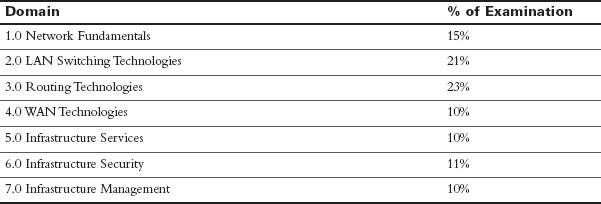
Table I-1 CCNA 200-125 Exam Domains and Weightings
Although Cisco outlines general exam topics, not all topics might appear on the CCNA exam; likewise, topics that are not specifically listed might appear on the exam. The exam topics that Cisco provides and this book covers are a general framework for exam preparation. Be sure to check Cisco’s website for the latest exam topics.
Registering for the CCNA 200-125 Exam
If you are starting your 31 Days Before Your CCNA Routing & Switching Exam today, register for the exam right now. In my testing experience, there is no better motivator than a scheduled test date staring me in the face. I’m willing to bet the same holds true for you. Don’t worry about unforeseen circumstances. You can cancel your exam registration for a full refund up to 24 hours before taking the exam. So if you’re ready, gather the following information in Table I-1 and register right now!
- Legal name
- Social Security or passport number
- Company name
- Valid email address
- Method of payment
You can schedule your exam at any time by visiting www.pearsonvue.com/cisco/. I recommend that you schedule it for 31 days from now. The process and available test times vary based on the local testing center you choose.
Remember, there is no better motivation for study than an actual test date. Sign up today.
Packet Tracer
To get your copy of Packet Tracer software, go to the companion website for instructions. To access this companion website, follow these steps:
Step 1. Go to http://www.ciscopress.com/register and log in or create a new account.
Step 2. Enter the ISBN 9781587205903.
Step 3. Answer the challenge question as proof of purchase.
Step 4. Click the Access Bonus Content link in the Registered Products section of your account page, to be taken to the page where your downloadable content is available.
About the Author
Allan Johnson entered the academic world in 1999 after 10 years as a business owner/operator to follow his passion for teaching. He holds both an MBA and an M.Ed. in Occupational Training and Development. Allan taught CCNA courses at the high school level for 7 years and has taught both CCNA and CCNP courses at Del Mar College in Corpus Christi, Texas. In 2003, Allan began to commit much of his time and energy to the CCNA Instructional Support Team, providing services to Networking Academy instructors worldwide and creating training materials. He now works full time for Cisco Networking Academy as a Learning Systems Developer.
About the Technical Reviewer
Rick McDonald teaches computer and networking courses via distance from the University of Alaska–Fairbanks campus, where he is a Professor of Information Systems. He holds a BA in English and an M.Ed. in Educational Technology from Gonzaga University in Spokane, Washington. His current academic focus is developing methods for delivering hands-on training in Alaska using web-based teaching tools.
